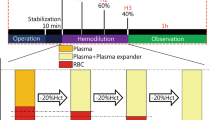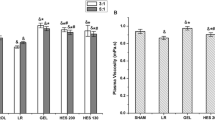Abstract
Objective
To compare the colloids 5% albumin, 4% gelatin and 6% hydroxyethyl starch (HES) 130/0.4 with each other and with saline, regarding their plasma-expanding effects after haemorrhage; these were also compared with the intravascular volume-expanding effect of re-transfusion with erythrocytes.
Design
Controlled, prospective, randomised laboratory study.
Setting
University research laboratory.
Subjects
Thirty-five adult rats.
Interventions
Plasma volume was determined (I125 albumin tracer technique) after haemorrhage of 20 ml/kg and 3 h after a bolus infusion of 20 ml/kg of each of the colloids or 80 ml/kg of saline, or 6.7 ml/kg of erythrocytes diluted in 9 ml/kg of saline. Blood pressure, haematocrit (Hct), blood gases and physiological parameters were measured.
Measurements and results
Plasma volume after haemorrhage was 29.6±2.6 ml/kg (n=35). With the bolus infusion, plasma volume increased by 21.1±3.6 ml/kg in the albumin group (n=7), by 13.1±2.9 ml/kg in the gelatin group (n=7), by 13.8±2.2 ml/kg in the HES group (n=7), by 16.0±2.4 ml/kg in the saline group (n=7) and by 6.9±2.3 ml/kg in the erythrocyte group (n=7) 3 h after the infusion. In the latter group, there was a total increase in intravascular volume of 13.6±2.5 ml/kg including the erythrocyte volume. Arterial pressure was better preserved in the albumin and erythrocyte groups than in the other groups.
Conclusion
Albumin 5% was a more effective plasma volume expander than gelatin and HES. Saline, with a four times larger volume, and erythrocytes in about 1/3 of the volume had a similar volume-expanding effect to gelatin and HES.

Similar content being viewed by others
References
Imm A, Carlson RW (1993) Fluid resuscitation in circulatory shock. Crit Care Clin 9:313–333
Hinshaw LB (1996) Sepsis/septic shock: participation of the microcirculation: an abbreviated review. Crit Care Med 24:1072–1078
Davies MG, Hagen PO (1997) Systemic inflammatory response syndrome. Br J Surg 84:920–935
Haljamae H (1985) Rationale for the use of colloids in the treatment of shock and hypovolemia. Acta Anaesthesiol Scand Suppl 82:48–54
Zornow MH, Prough DS (1995) Fluid management in patients with traumatic brain injury. New Horiz 3:488–498
Hillman K, Bishop G, Bristow P (1997) The crystalloid versus colloid controversy: present status. In: Haljamae H (ed) Plasma volume support. Saunders, London, pp 1–13
Haljamäe H (1996) Crystalloids vs colloids. In: Risberg B (ed), Trauma care—an update,. Pharmacia Upjohn Sverige, Mölndal, Sweden, pp 129–141
Taylor AE, Granger DN (1984) Exchange of macromolecules across the microcirculation. In: Handbook of physiology. Am Physiol Soc, Bethesda, MD, p 467
Fleck A, Raines G, Hawker F, Trotter J, Wallace PI, Ledingham IM, Calman KC (1985) Increased vascular permeability: a major cause of hypoalbuminaemia in disease and injury. Lancet 1:781–784
Degremont AC, Ismail M, Arthaud M, Oulare B, Mundler O, Paris M, Baron JF (1995) Mechanisms of postoperative prolonged plasma volume expansion with low molecular weight hydroxyethyl starch (HES 200/0.62, 6%). Intensive Care Med 21:577–583
James MF, Latoo MY, Mythen MG, Mutch M, Michaelis C, Roche AM, Burdett E (2004) Plasma volume changes associated with two hydroxyethyl starch colloids following acute hypovolaemia in volunteers. Anaesthesia 59:738–742
Mortelmans Y, Merckx E, van Nerom C, Verbruggen A, van Aken H, de Roo M, Mortelmans L (1995) Effect of an equal volume replacement with 500 ml 6% hydroxyethyl starch on the blood and plasma volume of healthy volunteers. Eur J Anaesthesiol 12:259–264
Wahba A, Sendtner E, Birnbaum DE (1996) Fluid resuscitation with Haemaccel vs human albumin following coronary artery bypass grafting. Thorac Cardiovasc Surg 44:178–182
Karanko MS (1987) Effects of three colloid solutions on plasma volume and hemodynamics after coronary bypass surgery. Crit Care Med 15:1015–1022
Rehm M, Haller M, Orth V, Kreimeier U, Jacob M, Dressel H, Mayer S, Brechtelsbauer H, Finsterer U (2001) Changes in blood volume and hematocrit during acute preoperative volume loading with 5% albumin or 6% hetastarch solutions in patients before radical hysterectomy. Anesthesiology 95:849–856
Ickx BE, Bepperling F, Melot C, Schulman C, Van der Linden PJ (2003) Plasma substitution effects of a new hydroxyethyl starch HES 130/0.4 compared with HES 200/0.5 during and after extended acute normovolaemic haemodilution. Br J Anaesth 91:196–202
Beards SC, Watt T, Edwards JD, Nightingale P, Farragher EB (1994) Comparison of the hemodynamic and oxygen transport responses to modified fluid gelatin and hetastarch in critically ill patients: a prospective, randomized trial. Crit Care Med 22:600–605
Hiippala S, Teppo AM (1996) Perioperative volume effect of HES 120/0.7 compared with dextran 70 and Ringer acetate. Ann Chir Gynaecol 85:333–339
Chiara O, Pelosi P, Brazzi L, Bottino N, Taccone P, Cimbanassi S, Segala M, Gattinoni L, Scalea T (2003) Resuscitation from hemorrhagic shock: experimental model comparing normal saline, dextran and hypertonic saline solutions. Crit Care Med 31:1915–1922
Van der Linden PJ, De Hert SG, Daper A, Trenchant A, Schmartz D, Defrance P, Kimbimbi P (2004) 3.5% urea-linked gelatin is as effective as 6% HES 200/0.5 for volume management in cardiac surgery patients. Can J Anaesth 51:236–241
Boldt J, Heesen M, Muller M, Pabsdorf M, Hempelmann G (1996) The effects of albumin versus hydroxyethyl starch solution on cardiorespiratory and circulatory variables in critically ill patients. Anesth Analg 83:254–261
Boldt J, Ducke M, Kumle B, Papsdorf M, Zurmeyer EL (2004) Influence of different volume replacement strategies on inflammation and endothelial activation in the elderly undergoing major abdominal surgery. Intensive Care Med 30:416–422
Dieterich HJ (2003) Recent developments in European colloid solutions. J Trauma 54:S26–30
Hebert PC, Wells G, Blajchman MA, Marshall J, Martin C, Pagliarello G, Tweeddale M, Schweitzer I, Yetisir E (1999) A multicenter, randomized, controlled clinical trial of transfusion requirements in critical care. Transfusion Requirements in Critical Care Investigators, Canadian Critical Care Trials Group. N Engl J Med 340:409–417
Vincent JL, Baron JF, Reinhart K, Gattinoni L, Thijs L, Webb A, Meier-Hellmann A, Nollet G, Peres-Bota D (2002) Anemia and blood transfusion in critically ill patients. JAMA 288:1499–1507
Valeri CR, Cooper AG, Pivacek LE (1973) Limitations of measuring blood volume with iodinated I 125 serum albumin. Arch Intern Med 132:534–538
Guo Y, Hedqvist P, Gustafsson LE (2001) Absence of mast cell involvement in active systemic anaphylaxis in rats. Eur J Pharmacol 430:305–310
Majde JA (2003) Animal models for hemorrhage and resuscitation research. J Trauma 54:S100–105
Guyton A, Hall J (2000) Textbook of medical physiology. Saunders, Philadelphia
Lundin S, Folkow B, Rippe B (1981) Central blood volume in spontaneously hypertensive rats and Wistar-Kyoto normotensive rats. Acta Physiol Scand 112:257–262
Arfors K-E, Buckley PB (1997) Pharmacological characteristics of artificial colloids. In: Haljamae H (ed) Plasma volume support. Saunders, London, pp 15–47
Rippe B, Haraldsson B (1994) Transport of macromolecules across microvascular walls: the two-pore theory. Physiol Rev 74:163–219
Grocott MP, Hamilton MA (2002) Resuscitation fluids. Vox Sang 82:1–8
Mortelmans YJ, Vermaut G, Verbruggen AM, Arnout JM, Vermylen J, Van Aken H, Mortelmans LA (1995) Effects of 6% hydroxyethyl starch and 3% modified fluid gelatin on intravascular volume and coagulation during intraoperative hemodilution. Anesth Analg 81:1235–1242
Lamke LO, Liljedahl SO (1976) Plasma volume changes after infusion of various plasma expanders. Resuscitation 5:93–102
(1998) Human albumin administration in critically ill patients: systematic review of randomised controlled trials. Cochrane Injuries Group Albumin Reviewers. BMJ 317:235–240
Finfer S, Bellomo R, Boyce N, French J, Myburgh J, Norton R (2004) A comparison of albumin and saline for fluid resuscitation in the intensive care unit. N Engl J Med 350:2247–2256
Michel CC, Curry FE (1999) Microvascular permeability. Physiol Rev 79:703–761
Valeri CR, Donahue K, Feingold HM, Cassidy GP, Altschule MD (1986) Increase in plasma volume after the transfusion of washed erythrocytes. Surg Gynecol Obstet 162:30–36
Järhult J, Holmberg J, Lundvall J, Mellander S (1976) Hyperglycemic and hyperosmolar responses to graded hemorrhage. Acta Physiol Scand 97:470–475
Acknowledgements
The study was supported by grants from the Swedish Research Council (No. 11581), from the Medical Faculty of Lund, Sweden, from Region Skåne, Sweden. Skilful technical aid from Helén Davidsson is gratefully acknowledged.
Author information
Authors and Affiliations
Corresponding author
Rights and permissions
About this article
Cite this article
Persson, J., Grände, PO. Volume expansion of albumin, gelatin, hydroxyethyl starch, saline and erythrocytes after haemorrhage in the rat. Intensive Care Med 31, 296–301 (2005). https://doi.org/10.1007/s00134-004-2510-3
Received:
Accepted:
Published:
Issue Date:
DOI: https://doi.org/10.1007/s00134-004-2510-3




